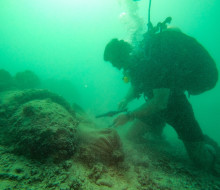
Second World War-era bombs in Vanuatu made safe by Navy divers
26 June 2024
Unfortunately you are viewing this website on an outdated browser which does not support the necessary features for us to provide an adequate experience. Please switch to a modern browser such as latest version of Google Chrome, Mozilla Firefox, Apple Safari or Microsoft Edge.
Ngā mihi nui
A Far North bay has provided an ideal location for New Zealand and United States naval divers and hydrographers to hone their mine-clearing skills and processes.
Tauranga Bay, north of the Bay of Islands, was the venue for two-week Exercise Nautilus, which ended earlier this month.
The Royal New Zealand Navy’s mine countermeasures capability element from HMNZS Matataua was joined by the US Navy’s Explosive Ordnance Disposal Mobile Unit One (USN EODMU1).
The contingent, of around 60 people - including chefs, engineers and communicators, set up base at a local camping ground.
Two long-range high-speed Littoral Manoeuvre Craft (LMC) powered up the coastline from Devonport Naval Base in Auckland, arriving in Tauranga Bay in less than five hours.
Chief Petty Officer Hydrographic Survey Technician Ryan Hulse, Autonomous Underwater Vehicle (AUV) mission planner, says Tauranga Bay is an ideal location for such an exercise.
“There are lots of different environments. There are multiple littoral beach zones, a harbour for sheltered operations, deeper water close by, and because we brought the LMCs up, a marina around the corner.”
Dummy mine-like objects were placed in a variety of locations around Tauranga Bay.
The job of locating them started with hydrographers, who deploy AUVs to scan the sea floor, using side-scan sonar to identify objects of interest.
The results are displayed back at camp, where an AUV operator studies the suggestive shape of a sonar ‘contact of interest’.
That information and location is passed to the divers. The divers then investigate each contact, confirm what it is, and ‘dispose’ of the mine.
Visibility underwater was mixed for the divers but hand-held Diver Underwater Search Systems helped them locate items.
The exercise was HMNZS Matataua’s biggest domestic exercise this year.
Hosting the US Navy was a good opportunity to further develop interoperability and interchangeability between the two diving units, Chief Petty Officer Hulse said.
“It was also an opportunity to innovate and discuss initiatives to improve all of our mine warfare processes and procedures.
“They were very appreciative for the opportunity to come to New Zealand to work alongside us, rather than bumping into each other at overseas exercises. It allowed us to work closely alongside one another and get more involved in all aspects.”
Exercise Nautilus was a fantastic opportunity for HMNZS Matataua to further cement its global reputation as a highly professional and agile mine warfare force,” Chief Petty Officer Hulse said.
“We got to work side by side with our US partners, learning and collaborating. Both nations conduct very similar work, with similar equipment and its likely one day very soon we will be working side by side on an operation together.”
He said locals and campers were curious and sometimes there would be a line of deck chairs on the beach as people watched what was happening.
“People were really interested in what we do.”